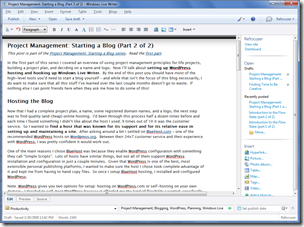Archive for March, 2009
Project Management: Starting a Blog (Part 2 of 2)
This post is part of the Project Management: Starting a Blog series. Read the first part.
 In the first part of this series I covered an overview of using project management principles for life projects, building out a project plan, and deciding on a name and logo for your blog. Now I’ll talk about setting up WordPress hosting and hooking up Windows Live Writer. By the end of this post you should have most of the high-level tools you’d need to start a blog yourself – and while that isn’t the focus of this blog necessarily, I do want to make sure that all this stuff I’ve learned over the last couple months doesn’t go to waste. If nothing else I can point friends here when they ask me how to do some of this!
In the first part of this series I covered an overview of using project management principles for life projects, building out a project plan, and deciding on a name and logo for your blog. Now I’ll talk about setting up WordPress hosting and hooking up Windows Live Writer. By the end of this post you should have most of the high-level tools you’d need to start a blog yourself – and while that isn’t the focus of this blog necessarily, I do want to make sure that all this stuff I’ve learned over the last couple months doesn’t go to waste. If nothing else I can point friends here when they ask me how to do some of this!
Project Management: Starting a Blog (Part 1 of 2)
This post is part of the Project Management: Starting a Blog series. Read the second part.
 Project management is a lost art and much needed science outside of corporate America. Many people spend most of their working lives planning projects for a living, but leave that toolbox in the office when they jet for home. However, life is a series of projects – some of them so complex they would put to shame anything you’d encounter at work – and the same tactics that have been proven over the centuries to work for managing vast, interdependent projects like the Roman Aqueducts also work for cleaning out the basement on a Sunday afternoon.
Project management is a lost art and much needed science outside of corporate America. Many people spend most of their working lives planning projects for a living, but leave that toolbox in the office when they jet for home. However, life is a series of projects – some of them so complex they would put to shame anything you’d encounter at work – and the same tactics that have been proven over the centuries to work for managing vast, interdependent projects like the Roman Aqueducts also work for cleaning out the basement on a Sunday afternoon.
Project management doesn’t sound sexy though, does it? I’d bet you immediately imagined some geek with a clipboard, sitting in a cubicle, staring at a GANTT chart in Microsoft Project. But just work with me for a moment: what if the same process that works for that geek would work for you as well? Would it be worth a shot? What if learning some ”boring” project management skills helps you get that job you’ve always wanted, keeps you sane while moving across the country, or helps you to relax over your upcoming wedding?
Add little to little and there will be a big pile. Ovid 43 BCE – 17 CE
Over time I plan to cover project management in more detail and relate the strategies and tactics to focus and to life (an amorphous, ambiguous blob lacking structure). I strongly believe that solid project management skills can help you lose weight, get that degree you abandoned, start your own business, or… simply start a blog like I’m about to describe.
For now, let’s just examine how this blog got off the ground…
Introduction to the Flow State (part 2 of 2)
This post is part of the Introduction to the Flow State series. Read the first part.
"In the groove", "in the zone", "in the bubble", and "on auto-pilot" are all ways to describe what the Japanese call "muga", and what Dr. Mihaly Csikszentmihalyi (pronounced CHICK-sent-me-high-ee) dubbed "flow" in the 1980s.
Flow can be defined as a period in time in which one becomes so completely involved in an activity that all other thoughts and emotions – what some consider the "self" – are excluded from consciousness.
Raise the stakes and improve your skills
 Whatever the immediate activity we’re participating in, we need to continually find a way to 1) set clear goals, 2) find ways to measure progress and 3) raise the stakes when we become bored. In order to consistently achieve the flow state, we must continue to increase our skill set as well as the challenge, in order to avoid becoming disinterested, overwhelmed, or apathetic. This means striking a unique balance in which Dr. Csikszentmihalyi and Dr. Susan Jackson label the “C/S Balance” (challenge/skills) in their book “Flow in Sports”. The activity needs to be challenging, but not so challenging that it’s perceived as an impossibility. As your skill level increases, you’ll need to continually increase the level of personal challenge in the activity.
Whatever the immediate activity we’re participating in, we need to continually find a way to 1) set clear goals, 2) find ways to measure progress and 3) raise the stakes when we become bored. In order to consistently achieve the flow state, we must continue to increase our skill set as well as the challenge, in order to avoid becoming disinterested, overwhelmed, or apathetic. This means striking a unique balance in which Dr. Csikszentmihalyi and Dr. Susan Jackson label the “C/S Balance” (challenge/skills) in their book “Flow in Sports”. The activity needs to be challenging, but not so challenging that it’s perceived as an impossibility. As your skill level increases, you’ll need to continually increase the level of personal challenge in the activity.
Introduction to the Flow State (part 1 of 2)
This post is part of the Introduction to the Flow State series. Read the second part.
 "In the groove", "in the zone", "in the bubble", and "on auto-pilot" are all ways to describe what the Japanese call "muga", and what Dr. Mihaly Csikszentmihalyi (pronounced CHICK-sent-me-high-ee) dubbed "flow" in the 1980s.
"In the groove", "in the zone", "in the bubble", and "on auto-pilot" are all ways to describe what the Japanese call "muga", and what Dr. Mihaly Csikszentmihalyi (pronounced CHICK-sent-me-high-ee) dubbed "flow" in the 1980s.
Flow can be defined as a period in time in which one becomes so completely involved in an activity that all other thoughts and emotions – what some consider the "self" – are excluded from consciousness.
It’s during this episode that an athlete or artist is in the much desired yet elusive mental state required to push his or her limits in the quest for peak performance. While most people view flow strictly as an afterthought, there are some who deem it as the sole purpose of any type of activity or training due to the fact that it enhances their awareness, improves their mood, and most importantly, enables them to perform at a level of proficiency they wouldn’t otherwise be capable of.
Bruce Lee was an ardent believer in the flow state (he referred to it as wu-hsin, flow’s Cantonese counterpart) and stated, "The consciousness of self is the greatest hindrance to the proper execution of all physical action" (Tao of Jeet Kune Do, p7). He believed that "physical stoppage", or the opposite of wu-hsin, could create many problems for a martial artist, as it would almost always result in hesitation and self-doubt. It’s also said that he planned to use wu-hsin as his alibi should he ever have to legally defend a violent act, by simply stating that he did not do it, "it did it all by itself".
Increase Focus With Greek Yogurt, Almonds, and Green Tea
 The clock just hit 4pm and you’re sitting at your desk staring at your computer monitor with your eyelids heavier than boulders. Your last meal was 4 hours ago so your stomach is growling loud enough for the guy in the next office to hear, and your energy level couldn’t be lower if you were actually sleeping. You can’t concentrate, you can’t get your eyes to focus, and you feel like just curling up into a fetal position and giving up on the day.
The clock just hit 4pm and you’re sitting at your desk staring at your computer monitor with your eyelids heavier than boulders. Your last meal was 4 hours ago so your stomach is growling loud enough for the guy in the next office to hear, and your energy level couldn’t be lower if you were actually sleeping. You can’t concentrate, you can’t get your eyes to focus, and you feel like just curling up into a fetal position and giving up on the day.
But you can’t of course; you have work to do. So what do you do? There are a number of things you can do in times like this to increase your focus: one of the best things you could do is go for a brisk 10 minute walk to get your blood flowing. But another great option is to eat. In fact, you should have eaten something before you got to this stage, making it a point to eat something every few hours to keep yourself energized throughout the day.
Here’s a great, simple snack to pick you up – remember, it’s best consumed before you hit rock-bottom. I keep a small refrigerator in my office to make sure I’m never without these three essentials.
How to Read 200+ Blogs and Other Sites Everyday
(If you clicked on “what is this?” from the sidebar, you’ve come to the right place! This post will tell you all about how feeds and feed readers work. But if you’re just interested in getting email updates when Refocuser is updated, you can do that too!)
 The idea of reading over 200 blogs and other sites every single day sounds ridiculous, doesn’t it? In order to do this, you’d have to spend at least 60 seconds on each site assuming there haven’t been many updates, and if there’s anything new it could easily take 5-10 minutes each! Once you add this up you could end up spending more than 3 hours each day just scanning and reading stuff – which is the exact opposite of focus. For most people, this is just pure procrastination city!
The idea of reading over 200 blogs and other sites every single day sounds ridiculous, doesn’t it? In order to do this, you’d have to spend at least 60 seconds on each site assuming there haven’t been many updates, and if there’s anything new it could easily take 5-10 minutes each! Once you add this up you could end up spending more than 3 hours each day just scanning and reading stuff – which is the exact opposite of focus. For most people, this is just pure procrastination city!
There’s definitely a better way to do it, but it’s surprising how few people utilize it when you look at the stats. It’s called subscribing – so instead of you going out to all those sites and waiting for new information, the information comes to you in the form of a subscription.
Before I learned about RSS and Atom feeds, I was clicking around to dozens of sites multiple times per day like a crack addict in search of a hit. I would scan the entire page to see if anything had changed before moving on, and if something had changed I would spend a little extra time on that site. But in the 5 years since discovering feeds and feed readers, my routine is… well, it’s routine. I “read the paper” in the morning by scanning/reading through the overnight updates, I check-in during the afternoon to see what’s up, and then sometimes (but not always) I do another session in the early evening. Total time spent: 30-45 minutes maximum. And I subscribe to 227 different sites!
Writing in Microsoft Word Without Any Distractions
From LifeHacker:
Add-on utility WriteSpace turns Microsoft Word 2007 into a distraction-free writing environment with the push of a button—making productive writing easy.
For the past few months I’ve been looking for the ideal way to write drafts without distraction, especially given my somewhat unique writing situation (a big burst on Sunday). My two favorite tools for word processing/blogging on Windows are Word and Windows Live Writer (a fantastic application!) but to-date I haven’t been able to go completely distraction-free in those programs. With WriteSpace I now can – without sacrificing the power of Word.
This is how it looks and works after you install it.
4 Steps to Learn Any Physical Activity
 Interested in learning a new dance step or knitting pattern? Always wanted to learn how to throw a curveball or how to surf? Learning something physical comes naturally to some people. We all know the type of person who can be shown how to do something quite elaborate and within 3 minutes is doing it themselves. For most of us however, doing something physical may not come naturally or easy even if the motivation is there.
Interested in learning a new dance step or knitting pattern? Always wanted to learn how to throw a curveball or how to surf? Learning something physical comes naturally to some people. We all know the type of person who can be shown how to do something quite elaborate and within 3 minutes is doing it themselves. For most of us however, doing something physical may not come naturally or easy even if the motivation is there.
Learning a new physical activity can be hard. You feel clumsy and awkward, you feel like you’re being watched like a hawk, and you consider quitting when you’re not getting it right. But remember: everyone starts where they are, and the best dancer/fighter/runner/juggler (or insert your interest here) was where you are now once in their life. No one is born with near-perfect coordination over their body, it always takes some time to build it.
A number of years ago I did some training at the Straight Blast Gym, one of the best mixed martial arts gyms in the world. Other than being thrown around the mat like a ragdoll by UFC champ Randy Couture (yes, I’m a name dropper), I had the privilege of training with someone who has had a profound impact on the way people train in modern martial arts. His name is Matt Thornton and the steps I’m going to outline are based on his steps for learning a new martial arts movement as covered in his original Functional Jeet Kune Do series. But this is certainly not limited to punching, kicking, or choking – as you’ll likely see, the same steps work just as well for learning just about any physical activity provided you want to do it well and do it “for real” (i.e. you don’t just want to pretend you can pull it off, you actually want to be able to pull it off in a real setting).
How to Read 3 or More Books a Month
 Many people I know are frustrated that they don’t have the time to read more. Between a commute, a time-consuming job, family responsibilities, and other hobbies, there just isn’t enough time in the day to start, much less finish, the book sitting on your nightstand. I’m certainly no exception – far too often I start a book with good intentions, just to have it collect dust next to my bed until I just give up and put it back on the shelf.
Many people I know are frustrated that they don’t have the time to read more. Between a commute, a time-consuming job, family responsibilities, and other hobbies, there just isn’t enough time in the day to start, much less finish, the book sitting on your nightstand. I’m certainly no exception – far too often I start a book with good intentions, just to have it collect dust next to my bed until I just give up and put it back on the shelf.
Sometimes it’s natural – not all books are worth finishing, and if you feel like you’ve already received 99% of the value in 10% of the time, sometimes it’s best to just move on. But oftentimes it takes a while for a book to get interesting, and giving up too soon means you’ll never know. Yet if you stick with it and don’t actually make the time to read, it could take 2-3 months to actually make it through – which means you may get to read just 3-4 books in a year.
There’s a better way. Note that some of these tips are clearly for people who a) want and love to read, and b) are frustrated with the amount of reading they can do. If you enjoy taking your time reading through a novel, ignore this post – but if learning and self-improvement are your goals, these tips can work wonders. Most of the books I read are non-fiction: self-help, fitness, productivity, business profiles, motivation, and so on. With books like these, I’m not looking for an experience, I’m looking for tools and tactics. And the more quickly I can synthesize and incorporate the information into my life the better!
7 Tips to Make Exercise a Habit (and Keep It That Way)
 Keeping up with regular exercise, just like most good things for you, comes down to building and maintaining habits. It’s not always easy to throw on those sweats and make the trek to the gym or the park when the comfort of your pillow is so much more inviting – especially on a cold morning. But there are ways to make that sweat a little more inviting, possibly even fun!
Keeping up with regular exercise, just like most good things for you, comes down to building and maintaining habits. It’s not always easy to throw on those sweats and make the trek to the gym or the park when the comfort of your pillow is so much more inviting – especially on a cold morning. But there are ways to make that sweat a little more inviting, possibly even fun!
First, let’s start with: why exercise at all? There are obvious numerous physical benefits to exercise ranging from reduced risk of heart disease & Type II diabetes to more physical strength for everyday activities. These benefits are simply too numerous to list in a single post and should really be common knowledge at this point for anyone over the age of 10. But the hidden benefits to exercise lie not in the body but in the impact to the mind.



